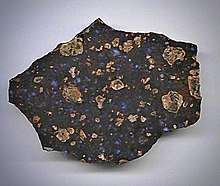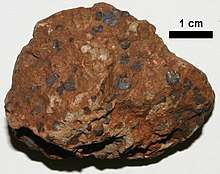Llanite
Llanite is a hypabyssally intruded variety of rhyolite with phenocrysts of microcline and euhedral quartz. The quartz crystals are blue hexagonal bipyramids. The unusual blue coloration of the quartz is thought to be due to ilmenite inclusions.[1] It is named after Llano County, Texas, the only place where it is found (geologists have identified other locations where similar types of rock may be found).[2] A dike of llanite crops out on Texas State Highway 16 about 9 miles north of the town of Llano.[3]


Llanite is very strong, with a crushing strength of 37,800 lb/in2 or 26,577,180 kg/m2.[4]
Modal mineralogy of llanite mode:[5]
- quartz - 34.6%
- microcline - 27.8%
- plagioclase - 27.9%
- biotite - 8.6%
- fluorite - 1.1%
- apatite - 0.14%
- magnetite - trace
- ilmenite - trace
- zircon - trace
See also
References
- Zolensky, M.E., Sylvester, P.J., and Paces, J.B. (1988) Origin and significance of blue coloration in quartz from Llano rhyolite (llanite), north-central Llano County, Texas. Am. Min. v. 73, p. 313-323.
- Reed, R. nd, Llanite in Africa. Archived 2012-03-19 at the Wayback MachineLlanite, Archived 2014-04-28 at the Wayback Machine Rob's Granite Page Archived 2011-04-04 at the Wayback Machine, The University of Texas at Austin, Austin, Texas.
- Roadside Geology of Texas, 1991, by Darwin Spearing
- Barnes, Virgil E. (1988) Geological Society of America Centennial Field Guide-- South-Central Section, p. 361-368.
- Iddings, J. P. (1904) Quartz-feldspar-porphyry (graphiphyro liparose-alaskose) from Llano, Texas. Journal of Geology, 12, p. 225-231.
External links
Heinrich, P. V., 2014, Llanite and the Blue Quartz of Texas. The Backbender's Gazette. vol. XLV, no. 5, pp. 5–12. (Houston Gem and Mineral Society, Houston, Texas).